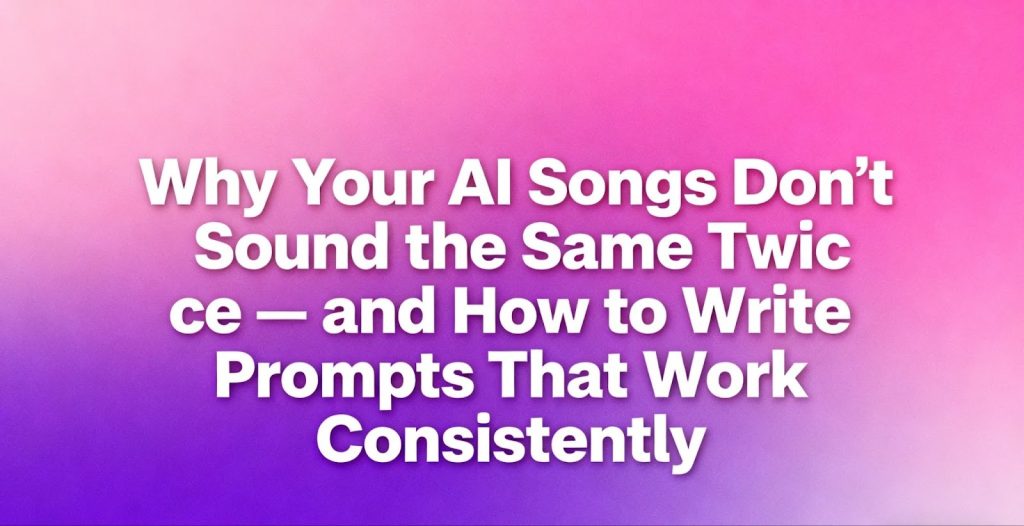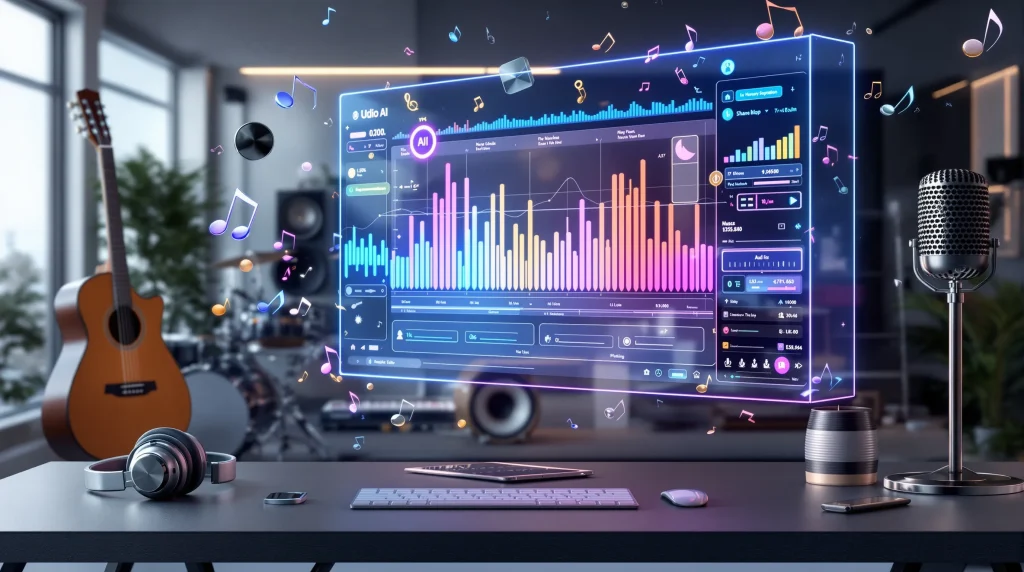AI가 생성한 곡은 사용자가 같은 프롬프트를 재사용하더라도 예상치 못한 변형을 가져와 뮤지션과 콘텐츠 크리에이터에게 불만을 야기하는 경우가 많습니다. 이러한 불일치는 생성 모델의 확률적 특성과 모델이 탐색하는 방대한 잠재 공간에서 발생하지만, 정밀한 AI 음악 프롬프트를 사용하면 이러한 불일치를 해결할 수 있습니다. 이 가이드에서는 변동성이 발생하는 이유, 안정성을 높이는 프롬프트 요소, 고급 엔지니어링 기술이 재현성을 높이는 방법을 살펴봅니다. 또한 이 글에서는 다음과 같은 방법을 강조합니다. 무레카의 MusiCoT 기술, 편집기 도구, 및 보컬 일관성 기능은 예측 가능한 결과를 지원합니다. 이러한 전략을 숙달하면 프로듀서와 애호가는 다음을 배울 수 있습니다. 매번 신뢰할 수 있는 브랜드 트랙을 생성하는 프롬프트 제작.
AI 노래가 매번 다르게 들리는 이유는 무엇인가요? AI 음악 출력 가변성 이해하기
AI 음악 출력 가변성은 동일한 프롬프트의 두 세대가 멜로디, 악기 또는 구조에서 차이가 나는 정도를 말합니다. 이 현상은 트랜스포머 및 확산 아키텍처에 내장된 확률적 샘플링 프로세스에서 비롯되며, 각 실행은 잠재 공간의 새로운 영역을 탐색합니다. 예를 들어, AI에게 “어쿠스틱 기타를 사용한 감미로운 인디 발라드”를 요청하면 실행할 때마다 다른 코드 진행이나 드럼 패턴이 생성될 수 있습니다. 이러한 기본 메커니즘을 이해하면 신속한 설계와 전문화된 도구를 통해 일관성을 제어할 수 있는 토대가 마련됩니다.
AI 음악 생성의 변동성 원인은 무엇인가요?
AI 음악 생성의 변동성은 확률론적 토큰 샘플링, 온도 설정, 모델 레이어의 다양성에서 비롯됩니다.
- 샘플링 방법 - 무작위 샘플링은 실행할 때마다 다른 높은 확률의 토큰을 선택합니다.
- 온도 제어 - 온도 값이 높을수록 음표와 리듬 선택의 무작위성이 증가합니다.
- 모델 레이어 노이즈 - 숨겨진 레이어에서의 확률 연산은 약간의 출력 변화를 가져옵니다.
이러한 요소들이 결합되어 신선한 음악적 아이디어가 나오지만 재현성을 저해할 수도 있으므로 모델을 안정적인 결과로 유도하는 정밀한 프롬프트 엔지니어링이 필요합니다.
트랜스포머와 확산 아키텍처와 같은 생성형 AI 모델은 가변성에 어떤 영향을 미칠까요?
트랜스포머와 확산 아키텍처는 각각 다중 주의 헤드와 반복적인 노이즈 제거 단계를 통해 프롬프트를 처리하여 음악 패턴의 고차원 잠재 공간을 생성합니다. 트랜스포머는 장르, 분위기, 가사 토큰에 주목하여 일관된 시퀀스를 조합하고, 확산 모델은 노이즈 파형을 점차적으로 멜로디로 정제합니다. 각 아키텍처의 샘플링 전략은 AI가 음악적 가능성을 얼마나 폭넓게 탐색하는지에 영향을 미치며, 이는 출력의 다양성으로 직결되고 일관된 결과를 위해 신중한 파라미터 제어가 필요합니다.
랜덤 시드와 잠재 공간은 AI 음악 차이에서 어떤 역할을 하나요?
랜덤 시드는 샘플링할 잠재 벡터를 결정하는 의사 난수 생성기를 초기화하여 모든 곡을 미묘하게 고유하게 만듭니다. 잠재 공간은 장르, 템포, 악기 등 압축된 음악적 속성을 나타내므로 시드 값을 변경하면 해당 공간의 다른 영역으로 이동합니다. 사용자는 시드를 고정하거나 샘플링 범위를 제한함으로써 여러 세션에서 유사한 음역대를 향해 AI를 조정하여 최종 트랙에서 원치 않는 변형을 줄일 수 있습니다.
학습 데이터의 다양성과 편향성은 AI 음악 일관성에 어떤 영향을 미칠까요?
학습 데이터의 다양성은 AI 모델에 다양한 스타일, 악기, 문화적 영향을 제공하지만, 예측할 수 없을 정도로 결과를 왜곡하는 편향성을 유발할 수도 있습니다. 일렉트로닉 댄스 음악 샘플이 지나치게 많으면 어쿠스틱 장르를 지정하는 프롬프트에서도 모델이 신디사이저 위주의 편곡을 기본값으로 설정할 수 있습니다. 데이터 세트 구성을 이해하면 프롬프트 제작자가 명시적인 설명자와 부정적 제약 조건으로 편향성을 상쇄하여 다양한 음악적 맥락에서 일관성을 개선할 수 있습니다.
일관된 AI 음악 프롬프트의 핵심 요소는 무엇인가요? 안정적인 AI 음악 생성을 위한 가이드
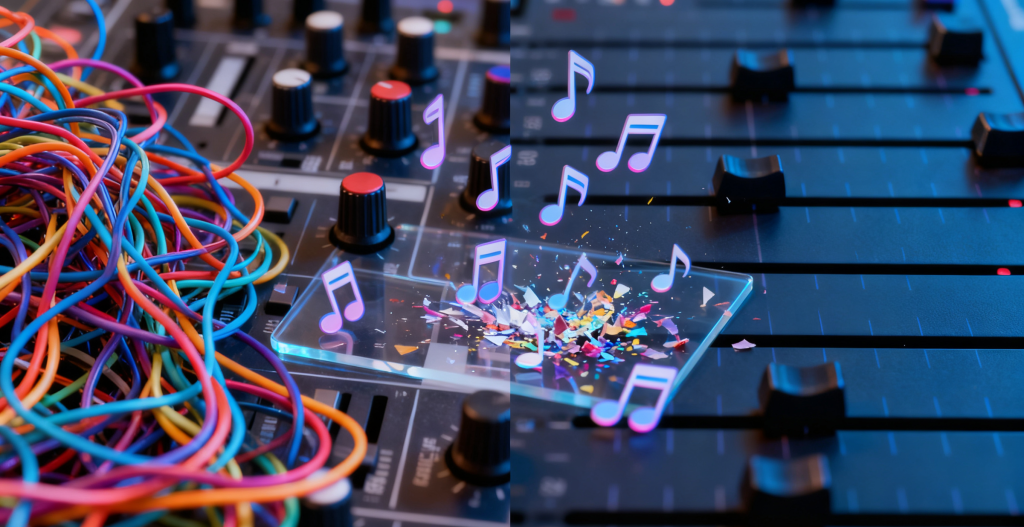
안정적인 AI 음악 프롬프트는 음악적 속성에 직접 매핑되는 세부 지침을 결합하여 세대를 거듭할수록 신뢰할 수 있는 결과를 제공합니다. 프롬프트 작성자는 장르, 분위기, 악기, 템포, 보컬 스타일, 구조를 정의함으로써 AI가 따라야 할 명확한 청사진을 제공합니다. 예를 들어 “따뜻한 아날로그 패드가 있는 1980년대 신스팝”이라고 지정하면 모델의 검색 공간이 좁아지고 사용자의 기대에 맞게 결과가 정렬됩니다. 이러한 핵심 요소는 재현 가능한 생성 워크플로우의 근간을 형성합니다.
강력한 프롬프트에는 다음과 같은 필수 구성 요소가 포함되어야 합니다:
- 정확한 장르 및 하위 장르 사양
- 상세한 기분 및 감정 설명자
- 명확한 계측 및 배치 지침
- 정의된 템포, 리듬 및 동적 가이드라인
- 보컬 스타일 및 가사 구조 요구 사항
- 명시적인 곡 구조 및 양식 개요
제작자는 이러한 요소를 각 AI 음악 프롬프트에 결합하여 모델이 일관된 음향 결과를 도출하도록 안내하는 포괄적인 프레임워크를 구축할 수 있습니다.
장르와 하위 장르를 지정하면 AI 음악의 일관성이 어떻게 향상되나요?
장르와 하위 장르를 모두 지정하면 모델의 스타일 파라미터가 고정되어 인식 가능한 코드 진행, 악기 및 프로덕션 기법으로 안내합니다. 예를 들어 “비닐 크래클이 있는 로파이 칠홉 인스트루멘탈”이라고 명시하면 AI가 부드러운 비트와 앰비언트 텍스처로 초점을 좁힐 수 있습니다. 이러한 타겟팅된 지시는 관련 없는 스타일에 대한 탐색을 줄여주므로 사용자의 의도와 밀접하게 일치하고 여러 세대에 걸쳐 일관성을 유지하는 결과물을 얻을 수 있습니다.
기분, 감정, 분위기 설명자가 안정적인 출력에 필수적인 이유는 무엇인가요?
기분 및 분위기 설명자는 AI 내에서 화음 선택, 멜로디 윤곽, 믹싱 결정을 지시하는 감정적 컨텍스트를 제공합니다. “우울하지만 희망적” 또는 “활기차고 모험적”과 같은 문구는 모델에 마이너 또는 메이저 음조를 선호하고, 리듬 강도를 높이고, 적합한 동적 팔레트를 적용하도록 신호를 보냅니다. 이러한 감정적 마커는 일관된 정서적 틀을 만들어 각 세대가 의도한 느낌에 공감할 수 있도록 합니다.
프롬프트에서 계측 및 배열을 어떻게 자세히 설명해야 하나요?
명확한 인스트루먼트 지침을 통해 어떤 사운드를 전경에 배치하고 텍스처를 어떻게 레이어링할지 AI에 알려줍니다. “핑거픽 어쿠스틱 기타 인트로, 따뜻한 아날로그 신스 베이스, 브러시드 스네어'를 지정하면 정확한 편곡 계층 구조가 윤곽을 드러냅니다. 이렇게 하면 악기 역할에 대한 모호함이 제거되고 예측할 수 없는 오케스트레이션을 방지하여 AI가 유사한 텍스처 블렌드를 복제하고 개별 렌더링에서 일관성을 유지할 수 있습니다.
어떤 템포, 리듬, 다이내믹 디테일이 예측 가능한 AI 음악을 보장할까요?
템포, 리듬 스타일, 다이나믹 레인지를 정의하면 트랙의 에너지와 페이스를 고정할 수 있습니다. “100 BPM, 스윙 삼박자 느낌, 부드러운 절, 폭발적인 코러스'와 같은 프롬프트 요소는 명확한 리듬과 볼륨 윤곽을 설정합니다. 이러한 시간적, 표현적 속성의 일관성은 AI의 시퀀싱 알고리즘이 균일한 그루브와 강도를 가진 트랙을 제공하도록 지시합니다.
보컬 스타일과 구조화된 가사는 일관성에 어떤 영향을 미치나요?
보컬 스타일 설명(예: “숨이 멎을 듯한 하모니의 거친 남성 리드”)과 구조화된 가사 윤곽선을 함께 사용하면 모델이 여러 테이크에서 멜로디와 프레이즈를 조정하는 데 도움이 됩니다. 프롬프트 내에 절, 코러스, 브릿지 레이블을 제공하면 AI가 안정적인 보컬 형태를 유지하여 반복 가능한 멜로디 모티프와 주제적 일관성을 유지할 수 있습니다.
프롬프트에서 노래 구조와 형태를 정의하는 것이 중요한 이유는 무엇인가요?
노래 섹션과 트랜지션의 윤곽을 지정하면 AI의 작곡 과정에 대한 로드맵이 제공됩니다. “인트로(0:00~0:15), 절, 코러스, 절, 브릿지, 코러스, 아웃트로”를 표시하면 모델에 타이밍과 섹션 순서를 지시할 수 있습니다. 이러한 구조적 명확성은 세대 간 형태 변화를 방지하고 예측 가능한 트랙 길이와 편곡을 제공합니다.
고급 프롬프트 엔지니어링 기술로 어떻게 일관성 있는 AI 음악을 얻을 수 있을까요?
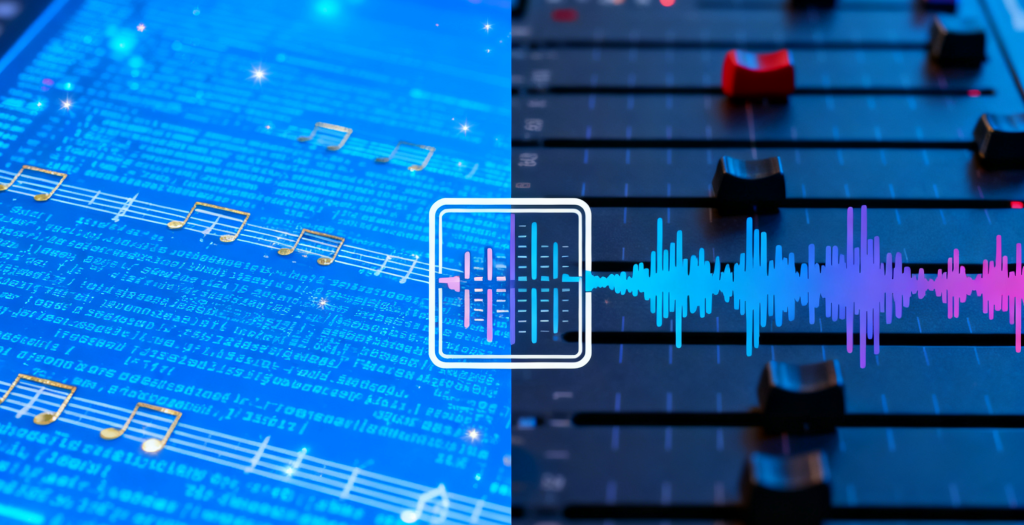
고급 프롬프트 엔지니어링 는 반복적인 개선, 모듈식 프롬프트 체인, 제외 컨트롤을 활용하여 재현성을 세밀하게 조정합니다. 프롬프트를 일회성 명령이 아닌 진화하는 청사진으로 취급함으로써 크리에이터는 원하는 결과물을 체계적으로 수렴할 수 있습니다. 네거티브 프롬프트 및 페르소나 생성과 같은 기술은 모델의 출력 공간을 더욱 제한하여 안정적이고 예측 가능한 AI 음악 결과를 제공합니다.
고급 엔지니어링 방법에는 다음이 포함됩니다:
- 점진적인 정밀도를 위한 반복적인 프롬프트 개선
- 모듈식 지침을 위한 프롬프트 체인 및 다중 파트 프롬프트
- 원치 않는 요소를 제외하라는 부정적 메시지 표시
- 스타일 전달을 위한 참조 오디오 또는 멜로디 모티프
- 일관된 보컬 속성을 위한 페르소나 생성
이러한 방법을 조합하여 적용하면 생성 프로세스에 대한 제어를 강화하고 반복 가능한 결과물을 확보할 수 있습니다.
반복적 프롬프트 개선이란 무엇이며 어떻게 결과를 개선하나요?
반복적인 프롬프트 개선에는 초기 광범위한 프롬프트를 시작하고 출력을 검토한 다음 설명자 또는 매개변수를 조정하여 선호하는 속성을 구체화하는 과정이 포함됩니다. 이러한 단계적 튜닝은 AI의 초점을 좁혀 창의적인 유연성을 유지하면서 가변성을 줄입니다. 반복 주기는 일관된 음악적 특징을 유발하는 용어의 정확한 조합을 정확히 찾아내는 데 도움이 됩니다.
프롬프트 체인 및 다중 파트 프롬프트는 어떻게 재현성을 향상하나요?
프롬프트 연쇄는 복잡한 지침을 장르와 분위기, 악기, 구조 등 순차적인 부분으로 나누고 AI가 단계적으로 처리합니다. 여러 부분으로 구성된 프롬프트는 모델이 점진적으로 통합하는 계층화된 지침을 제공하므로 보다 제어된 구성 프로세스를 구현할 수 있습니다. 이러한 모듈식 접근 방식은 각 주요 속성을 구획화하여 재현성을 향상시킵니다.
부정적 프롬프트란 무엇이며 원치 않는 요소를 어떻게 방지하나요?
네거티브 프롬프트는 “거친 신디사이저 리드 금지” 또는 “바닥에 4번 차는 패턴 피하기”와 같이 AI가 피해야 할 사항을 지정합니다. 원치 않는 기능을 명시적으로 제외함으로써 크리에이터는 원치 않는 아티팩트를 제거하고 일반적인 장르의 진부한 표현에서 벗어난 결과물을 만들 수 있습니다. 네거티브 제약 조건은 생성 경계를 강화하고 즉각적인 명확성을 향상시킵니다.
레퍼런스 오디오와 멜로디 모티프가 AI 음악 스타일을 어떻게 안내하나요?
레퍼런스 오디오 또는 멜로디 모티브에 대한 짧은 설명(예: 90년대 R&B 베이스라인 모티브 스타일)을 포함하면 모델에 구체적인 스타일 앵커를 부여할 수 있습니다. 이러한 레퍼런스는 여러 세대에 걸쳐 하모니, 리듬, 톤을 일치시키는 스타일 전이 단서 역할을 합니다. 일관된 모티프 사용은 각 렌더링에서 안정적인 캐릭터를 보장합니다.
페르소나 생성은 어떻게 노래 전반에 걸쳐 보컬의 일관성을 보장하나요?
페르소나 생성은 모든 보컬 세대에 “숨결이 느껴지는 소울풀한 여성 가수'와 같은 가상의 보컬리스트 프로필을 할당합니다. 이렇게 정의된 페르소나는 AI가 멜로디와 음색 선택에 적용하는 재사용 가능한 자산이 되어 여러 트랙에서 보컬 텍스처와 프레이징의 일관성을 유지합니다.
Mureka의 기술은 어떻게 안정적이고 일관된 AI 음악 생성을 지원하나요?
Mureka의 플랫폼은 독점적인 MusiCoT 기술과 강력한 편집기 및 보컬 일관성 도구를 통합하여 재현 가능한 결과를 제공합니다. 이러한 조합을 통해 크리에이터는 구조를 미리 계획하고, 출력을 다듬고, 보컬 프로필을 고정하여 모든 단계에서 변동성을 최소화할 수 있습니다. Mureka 는 고급 컨트롤을 인터페이스에 직접 내장하여 핵심 프롬프트 엔지니어링을 향상시킵니다.
| 기능 | 기능 | 영향 |
|---|---|---|
| MusiCoT 사전 계획 | 노래 섹션 및 트랜지션 미리 계획하기 | 일관된 구조를 보장하고 배열 편차를 줄입니다. |
| 에디터 미세 조정 | 생성 후 파형 및 MIDI 조정 기능 제공 | 정밀한 제어를 위한 반복적 세분화 가능 |
| 보컬 일관성 도구 | 가수 페르소나와 멜로디 모티프에 잠금 설정 | 안정적인 보컬 음색과 프레이징 유지 |
| 고급 모드 매개변수 | 온도, 시드 값 및 샘플링 방법을 조정합니다. | 예측 가능한 출력 경계 제공 |
이러한 기능을 종합하면 창의성과 제어가 공존하는 환경을 조성하여 AI가 무작위적인 변형을 피하고 신뢰할 수 있는 음악적 결과를 도출하도록 유도합니다.
MusiCoT 기술이란 무엇이며 곡 구조의 일관성을 어떻게 개선하나요?
MusiCoT(Music Chain-of-Thought) 기술은 생성 전에 노래 섹션의 논리적 순서를 배치하여 인트로, 절, 코러스 등 각 파트가 일관되게 흐르도록 보장합니다. 전환을 매핑하고 섹션 길이를 정렬함으로써 MusiCoT는 구조적 드리프트를 줄이고 미리 정의된 블루프린트에 따라 출력을 정렬하여 각 실행이 동일한 형식을 따르도록 합니다.
무레카 에디터는 미세 조정과 반복적인 개선에 어떻게 사용할 수 있나요?
Mureka의 에디터는 초기 생성 후 사용자가 타이밍, 악기 레벨, 다이내믹을 조정할 수 있는 오디오 파형 및 MIDI 트랙 인터페이스를 제공합니다. 이러한 생성 후 세분화 작업을 통해 제작자는 사소한 불일치를 수정하고 원하는 음악적 특성을 강화하여 최종적으로 완성된 트랙에서 융합을 가속화할 수 있습니다.
무레카의 보컬 일관성 기능은 어떻게 안정적인 보컬 스타일을 유지하나요?
Mureka를 사용하면 프롬프트 작성자가 음색, 비브라토, 프레이징 선호도 등 보컬 페르소나를 선택하고 저장하면 이후 모든 보컬 생성에 AI가 적용합니다. 이러한 프로필을 저장하면 각 보컬 테이크가 선택한 페르소나와 일치하도록 하여 세션 간에 음색이 달라지는 것을 방지할 수 있습니다.
Mureka는 예측 가능한 출력을 위해 어떤 고급 모드 및 파라미터 제어 기능을 제공하나요?
고급 모드에서 사용자는 시드 값을 잠그고, 온도 임계값을 설정하고, 무작위 강도를 지정하는 샘플링 알고리즘을 선택할 수 있습니다. 이러한 제어는 AI의 잠재 공간 탐색을 형성하여 여러 번의 실행에서 일관된 멜로디와 리듬의 결과를 생성하는 좁은 생성 통로를 만듭니다.
일반적인 AI 음악 불일치 문제는 무엇이며 어떻게 해결할 수 있나요?
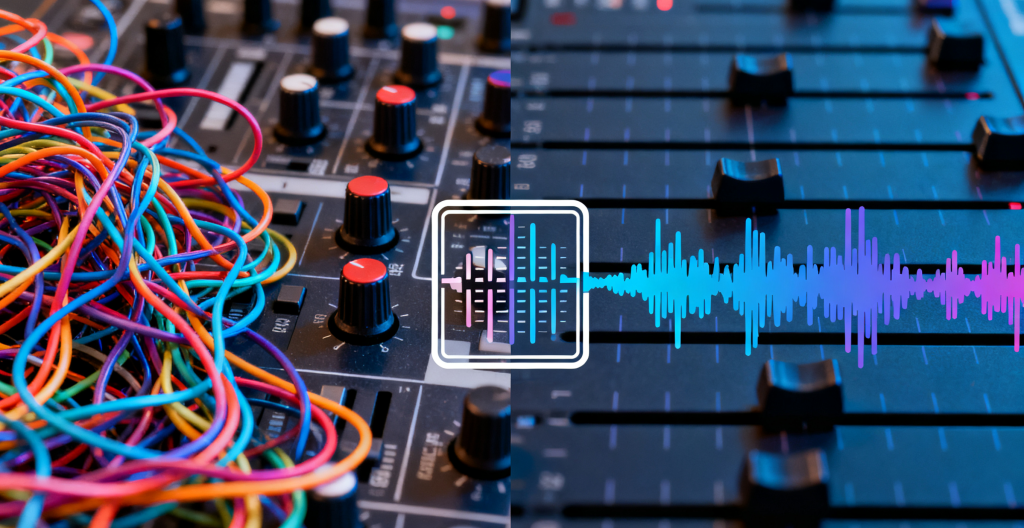
신중한 프롬프트에도 불구하고 AI 음악은 예기치 않은 장르 전환, 오디오 아티팩트, 가사 불일치 또는 길이 변화가 나타날 수 있습니다. 이러한 문제를 조기에 인식하고 수정 기술을 적용하면 낭비되는 반복을 방지하고 프로젝트의 연속성을 보장할 수 있습니다. 문제 해결에는 프롬프트 또는 설정 내에서 근본 원인을 진단한 다음 목표에 맞는 조정을 적용하는 것이 포함됩니다.
자주 발생하는 불일치는 다음과 같습니다:
- 예상치 못한 장르 또는 기분 전환
- 클리핑, 금속성 음색 또는 노이즈와 같은 아티팩트
- 가사 및 보컬 정렬 불일치
- 가변적인 곡 길이 및 구조적 편차
이러한 증상을 파악하고 즉각적인 수정 또는 편집기 조정으로 대응하면 일관성을 회복하고 워크플로 효율성을 유지할 수 있습니다.
AI 노래의 예상치 못한 장르나 분위기 변화를 어떻게 진단하나요?
예상치 못한 변화는 종종 프롬프트에서 설명어가 누락되거나 상충되는 것을 나타냅니다. 프롬프트를 검토하여 명확한 장르 레이블을 지정하고 원하는 분위기 용어를 강화하면 모순되는 단서를 제거할 수 있습니다. 또한 온도 설정을 줄이면 모델이 의도한 스타일을 벗어나 탐색하려는 경향을 억제할 수 있습니다.
음질을 개선하고 아티팩트를 줄이는 단계는 무엇인가요?
샘플링 파라미터를 조정하고 온도를 낮추고 Mureka의 에디터에서 고품질 렌더링 모드를 활성화하면 아티팩트를 최소화할 수 있습니다. 생성 후 부드러운 압축 또는 이퀄라이제이션을 적용하면 클리핑과 거친 주파수를 해결하여 일관된 음향 텍스처로 깔끔한 믹싱을 보장합니다.
가사 및 보컬 불일치를 어떻게 해결할 수 있을까요?
가사, 멜로디, 보컬 스타일이 하나의 프롬프트 블록 내에 정의되어 있는지 확인하면 정렬 오류를 줄일 수 있습니다. 불일치가 계속되면 프롬프트를 여러 부분으로 나누고(가사를 먼저 입력한 다음 멜로디 지침을 입력) 올바른 구문과 타이밍을 강화하세요.
곡의 길이와 구조 변화를 제어하는 데 도움이 되는 전략은 무엇인가요?
프롬프트에 명시적인 타임스탬프와 섹션 레이블(예: “3:15의 아웃트로” 또는 “두 번째 코러스 후 브리지”)을 포함하면 길이와 형식이 고정됩니다. 길이가 편차가 있는 경우 시드 값을 조정하거나 음수 프롬프트를 사용하여 불필요한 반복이나 추가 막대를 방지하세요.
일관성 있게 작동하는 AI 음악 프롬프트는 어떻게 작성하나요? 단계별 프롬프트 엔지니어링 가이드
일관되게 효과적인 AI 음악 프롬프트를 제작하려면 각 인스트럭션을 정의, 개선 및 검증하는 구조화된 프로세스가 필요합니다. 일련의 명확한 단계를 따르면 크리에이터는 최소한의 반복으로 안정적인 트랙을 생성하는 프롬프트를 체계적으로 구축할 수 있습니다. 이 접근 방식은 기본 프롬프트 요소와 고급 엔지니어링 기술을 결합하여 최적의 제어를 가능하게 합니다.
다음 필수 단계를 따르세요:
- 장르, 분위기, 악기 등 핵심 음악 속성을 정의합니다.
- 섹션 레이블로 곡의 구조와 타이밍을 개략적으로 설명합니다.
- 감정적 묘사와 서정적 테마를 통합하세요.
- 네거티브 제약 조건을 적용하여 원치 않는 요소를 필터링합니다.
- 참조 모티프 또는 페르소나 프로필을 앵커로 사용합니다.
- 출력을 검토하고 프롬프트를 반복적으로 수정합니다.
이러한 단계를 구현하면 모든 프롬프트가 AI에 포괄적인 청사진을 제공하여 일관된 음악적 결과물을 도출할 수 있습니다.
상세한 AI 음악 프롬프트를 제작하기 위한 필수 단계는 무엇인가요?
먼저 정확한 장르와 하위 장르를 선택한 다음, 분위기 설명자와 악기 설명을 레이어에 추가합니다. 그런 다음 템포, 리듬 스타일, 섹션 순서를 지정합니다. 마지막으로 서정적인 테마와 부정적인 제약 조건을 추가하여 바람직하지 않은 특성을 제거합니다. 이러한 단계적 구성은 각 속성을 프롬프트에 단단히 고정시킵니다.
주요 음악적 속성을 프롬프트에 어떻게 통합할 수 있나요?
장르 태그와 분위기 형용사, 악기 목록, 동적 가이드라인을 하나의 프롬프트 문장으로 결합하세요. 예를 들어 “강렬한 브라스 스탭, 드라이빙 베이스라인, 활기찬 보컬, 긴장감 넘치는 브릿지가 있는 120 BPM 일렉트로 펑크 트랙을 기타 왜곡 없이 제작하세요.”
예제와 템플릿을 사용하여 프롬프트의 일관성을 개선하려면 어떻게 해야 하나요?
장르, 분위기, 구조에 대한 자리 표시자가 포함된 성공적인 프롬프트 템플릿 라이브러리를 유지하면 신속하게 재사용하고 조정할 수 있습니다. 검증된 템플릿 내에서 속성 값을 교체하면 기본 프롬프트 아키텍처를 유지하여 일관된 결과를 얻을 수 있습니다.
Mureka의 어떤 도구와 기능이 효과적인 프롬프트 작성을 지원하나요?
Mureka의 프롬프트 빌더 인터페이스는 파라미터 프리셋, 시드 잠금, 네거티브 프롬프트 필드를 제공하여 각 속성 입력 시 사용자를 안내합니다. 에디터의 실시간 미리보기 및 변형 비교 차트는 전체 렌더링 전에 프롬프트 효과를 검증하는 데 도움이 됩니다.
여러 세대에 걸쳐 AI 음악의 일관성을 유지하기 위한 모범 사례는 무엇인가요?
장기적인 일관성을 유지하려면 지속적인 개선, 매개변수 추적, 과거 결과물로부터의 학습이 필요합니다. 버전이 지정된 프롬프트를 설정하고, 성과 지표를 모니터링하고, 사례 연구를 분석함으로써 제작자는 지속적으로 재현성을 개선할 수 있습니다. 사용자 피드백을 통합하면 프롬프트의 정확성을 더욱 개선하고 진화하는 프로젝트 요구사항에 맞게 결과물을 조정할 수 있습니다.
주요 사례는 다음과 같습니다:
- 반복적인 프롬프트 및 지속적인 튜닝
- 로그에서 프롬프트 매개변수 및 시드 값 추적하기
- 성공적인 프롬프트 결과의 사례 연구 검토
- 음악적 일관성에 대한 사용자 피드백 수집
이러한 모범 사례는 피드백 루프를 만들어 신속한 프레임워크를 강화하고 미래 세대에 걸쳐 안정성을 향상시킵니다.
반복 프롬프트는 출력을 개선하고 안정화하는 데 어떻게 도움이 되나요?
반복 프롬프트는 연속적인 출력을 대상 속성과 비교하여 프롬프트 제작자가 변형이 허용 가능한 범위 내에 들어갈 때까지 설명자, 매개 변수 또는 음수 제약 조건을 조정할 수 있도록 합니다. 반복할 때마다 원하는 음향 프로파일에 가까워집니다.
프롬프트 매개변수 추적 및 조정이 중요한 이유는 무엇인가요?
시드 값, 온도 설정, 설명자 가중치를 로깅하면 재현성을 위한 참고 자료가 됩니다. 출력이 변동될 때 이러한 로그를 다시 살펴보면 어떤 매개변수 조정으로 일관성을 회복할 수 있는지 알 수 있으므로 문제 해결에 소요되는 시간을 절약할 수 있습니다.
일관된 프롬프트 기술을 배우기 위해 사례 연구를 어떻게 활용할 수 있을까요?
일관된 스타일의 안정적인 앨범 시리즈와 같은 실제 사례를 분석하면 어떤 프롬프트 구조와 Mureka 기능이 신뢰할 수 있는 결과를 가져왔는지 알 수 있습니다. 이러한 성공 사례를 문서화하면 향후 프롬프트 제작을 위한 지식 기반이 구축됩니다.
사용자 피드백은 AI 음악 일관성 향상에 어떤 역할을 하나요?
공동 작업자나 청취자의 피드백은 분위기, 구조 또는 믹스 밸런스의 미묘한 불일치를 강조합니다. 이러한 관찰 사항을 즉각적인 수정 및 편집기 조정에 반영하면 각 세대가 프로젝트 표준을 충족할 수 있습니다.
고도로 제어 가능한 AI 음악 프롬프트를 제작하면 예측할 수 없는 결과물을 신뢰할 수 있는 창작 도구로 바꿀 수 있습니다. 프로듀서는 세부적인 속성 정의와 고급 엔지니어링 기술 및 Mureka의 특수 기능을 결합하여 자신의 예술적 비전에 부합하는 일관된 결과물을 얻을 수 있습니다. 다음 단계로 안정적인 AI 곡 제작을 시작하세요. Mureka AI 음악 생성기 오늘.

